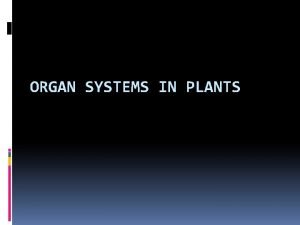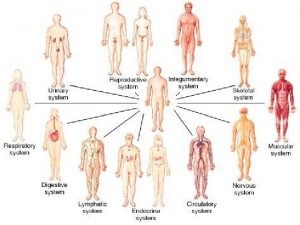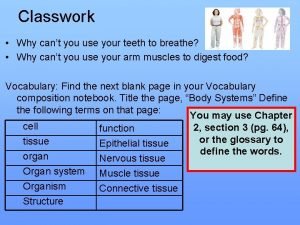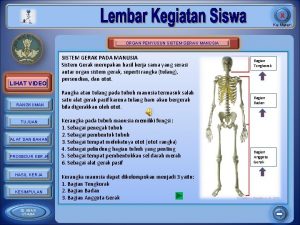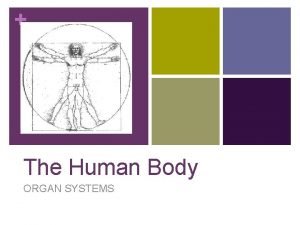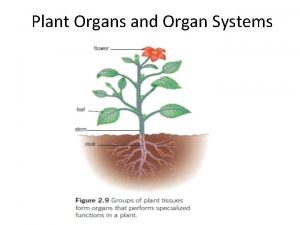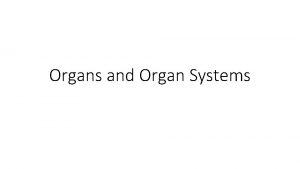Human Organ Systems Different organs can work together










- Slides: 10

Human Organ Systems Different organs can work together to perform a common function, like how the parts of your digestive system break down food. We refer to an integrated unit as an organ system. There are 11 major organ systems in the human body, which include the circulatory, respiratory, digestive, excretory, nervous and endocrine systems. The immune, integumentary, skeletal, muscle and reproductive systems are also part of the human body.

Digestive System The digestive system is responsible for bringing food into the body and breaking it down to useable components. As shown in the diagram below, it starts at the mouth, where we ingest our food and use our saliva, teeth and tongue to bite and mash it. The food then travels through the esophagus into the stomach, where strong acids break it down even further. During the last two stages of digestion, nutrients and water are absorbed through the small intestine and the large intestine, respectively. Any remaining waste products are stored in the rectum and eliminated through the anus.

Excretory System The urinary or excretory system is where liquid waste is eliminated as urine. The excretory system starts with the kidneys, important organs for cleaning the blood and balancing water in the body. In the excretory system, the liquid part of the blood, or plasma, enters through the kidneys, where important nutrients, like sugar and some salt, are reabsorbed into the body. Compounds we don't need, like urea or excess water, are sent to the bladder in the form of urine. Urine leaves the body through the urinary tract and exits the body at the urethra, as shown in the following illustration of the female urinary system.

Circulatory System The circulatory system is responsible for transporting blood throughout the body. It consists of the heart and blood vessels known as veins, arteries and capillaries. Think of blood vessels as the highways of the body, bringing important cargo to and from the cells. In the circulatory system, blood is pumped from the heart to the lungs, so they'll get oxygen, and then pumped to the body's cells. Here is a diagram of the human circulatory system, including the heart and major arteries, which are in red, and veins, which are in blue.

Respiratory System The respiratory system allows air to enter the lungs and for oxygen to diffuse into the blood en route to the body's tissues. The entrance to the respiratory system can be found in the nose and the mouth, where air enters the body and then travels through the larynx and pharynx in the throat to the trachea or windpipe. From the trachea, right and left branches, known as bronchi, carry oxygen to the alveoli, where oxygen moves into the blood, while carbon dioxide moves into the lungs to be exhaled.

Nervous System Without a master control system that tells our bodies what to do, none of the organ systems we've talked about so far would work. The organs in the human nervous system are made up of cells, called neurons, that use chemicals and electricity to send messages. This system has two main parts, the central nervous system (CNS) and the peripheral nervous system (PNS), which you can see in the diagram below. The central nervous system consists of the brain and the spinal cord, which serve as the main control centers for the body and process all incoming and outgoing messages. The peripheral nervous system includes all the nerves in your body that bring messages to the central nervous system and from the CNS to the muscles.

Endocrine System Whereas the nervous system mainly uses electrical signals to communicate between cells, the endocrine system relies upon chemicals, called hormones, to send long distance messages through the body. For example, instead of communicating directly by talking to your neighbor, you decide to send him or her a letter. The main organs found in the human endocrine system are located in the brain and include the hypothalamus, thalamus and pituitary gland. They talk to other endocrine organs, like the adrenal glands, testes and ovaries to assist with other organ systems. The following is an image of the different organs that make up the endocrine system and secrete hormones.

Immune System Now let's move on to the immune system which acts like the guardian of your body by keeping harmful things, like pathogens or toxins, out and fighting any infection that gets in. It is made up of a series of tubes called lymphatic vessels, that help to screen the blood for pathogens. The immune system also includes white blood cells that patrol through the lymphatic and circulatory systems checking for invaders. There are many types of white blood cells that work together in your immune system, which are illustrated below.

Skeletal System The skeletal system includes all of the bones and joints in the body. Each bone is a complex living organ that is made up of many cells, protein fibers, and minerals. The skeleton acts as a scaffold by providing support and protection for the soft tissues that make up the rest of the body. The skeletal system also provides attachment points for muscles to allow movements at the joints. New blood cells are produced by the red bone marrow inside of our bones. Bones act as the body’s warehouse for calcium, iron, and energy in the form of fat. Finally, the skeleton grows throughout childhood and provides a framework for the rest of the body to grow along with it.

Reproductive System The reproductive system or genital system is a system of sex organs within an organism which work together for the purpose of sexual reproduction. Many non-living substances such as fluids, hormones, and pheromones are also important accessories to the reproductive system. Unlike most organ systems, the sexes of differentiated species often have significant differences. These differences allow for a combination of genetic material between two individuals, which allows for the possibility of greater genetic fitness of the offspring.
 Organs working together
Organs working together All systems of the body
All systems of the body Cell tissue organ organ system organism
Cell tissue organ organ system organism Cell tissue organ organ system organism
Cell tissue organ organ system organism Organ penyusun sistem gerak bawah
Organ penyusun sistem gerak bawah Organ and organ system
Organ and organ system Foto rontgen efusi pleura
Foto rontgen efusi pleura Penyusun sistem saraf pusat adalah
Penyusun sistem saraf pusat adalah It is a bony cage enclosing vital human organs
It is a bony cage enclosing vital human organs Internal organs human body
Internal organs human body Opvoedbelasting
Opvoedbelasting
